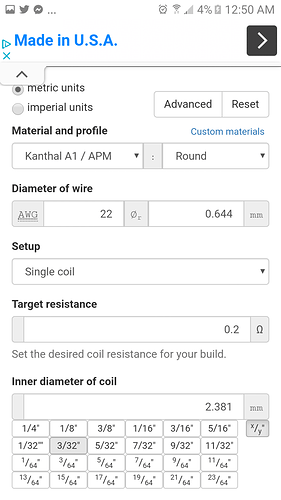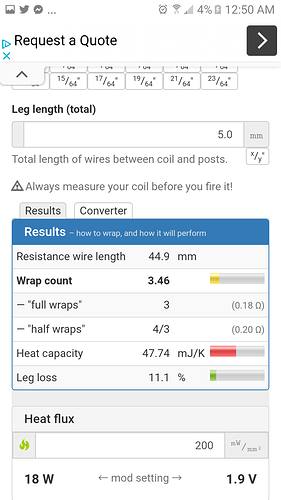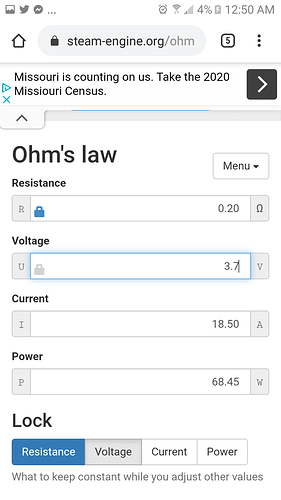Right now I have an aegis legend (200 watts, two 3.7 volt 18650 3000 mah 30Q 15 amp batteries) and I’m looking into building coils as a hobby (starting simple at first and wanting to do coils in between .15 ohmsto .3 ohms). I’d like to use kanthal wire. I’ve done a lot of research but still have some questions like which rta should id go for? Id like one that has two sets of terminals so i have the option to go dual coil if i want to. what’s the best, most cost effective kanthal wire? Which cotton should I use? How do I know what wattage to vape on? If I use the formula for wattage by squaring the voltage of the battery (3.7*3.7=x, x/.2 ohms=y) I get about 68 watts for a .2 ohm coil. Am I doing that right to figure out what wattage I should vape at? Something seems off about that method. I know the gauge of the wire and the amount of wraps you put in it determines the resistance. Any and all help is greatly appreciated. Thanks everyone.
Rtas I’m looking at are the Augvape INTAKE DUAL 26mm RTA and the Geek Vape Creed 25mm RTA. Whats the difference in mm mean?
This would be a good place to start
https://www.steam-engine.org/coil
25mm and 26mm refers to the diameter of the tank.
There will (unless in an unusual and these days probably unlikely design) be a Voltage multiplication (often a factor of 2), and minimum of ~0.3 Volts drop across any MOSFET output driver in series with the (composite) Coil(s) Loads - so it is not straightforward to try to approach analysis from the battery side. If you analyze the (battery) Current draw, there will exist some (quiescent, as well as operating) parallel Current draw (in the electronics) that will not be available to the (composite) Coil(s) Load.
(From what I can tell by squinting at some promotional pics), your Mod displays (output-referenced) Volts, Amperes, and Watts - describing (composite) Coil(s) Load (as opposed to describing the battery).
Vaping (composite Coil(s) Loads) Wattage depends upon the maximum (as well as the time-averaged) Temperatures that one wishes to be able to reach when vaping. The higher the power, the “faster” will be the rise-time of the coil-wick interface Temperature. “Pre-heating” decrease that rise-time delay.
Temperatures will depend upon various factors surrounding the coil-wick interface and ventilation.
It may be that you already known some/all of the above described information already. If so, great !
.
One (might well) want a minimum of ~9 turns for mechanical stability/durability of a single-coil.
Let’s tentatively model a 9-turn, #26 Gauge, 3mm inner-diameter coil with an ~10mm total lead length.
Using Kanthal A1/APM wire, that comes out to ~1.33 Ohms Resistance:
The very same coil constructed of Stainless Steel (316L) yields ~0.69 Ohm:
.
I myself have never used Cotton wicking material (as preferred by some). I use Rayon (“CelluCotton”).
From what I understand if the amperage in the ohms calculator is higher than the battery’ s amperage then it goes into a danger zone.
The power supply batteries will be connected in series, increasing total battery voltage possible (otherwise, they would “battle” each other, and consume unwanted currents between themselves).
If two coils are series-connected, then a doubling of the (output drive, average) Voltage is called for. That is (probably, don’t know) how things go - because the Current value flowing through the coils will be identical (Kirchhoff’s Law).
If the coils are parallel-connected, an increase of the (output drive, average) Current is called for. However, the individual coil Currents will vary if the coil Resistances differ (and they will, somewhat).
Your Mod displays Voltage, Current, Power (Watts) measured across/through the (composite) Coil(s) Load. Those measurements are what you need to rely upon. Know your (composite, that is - as series or parallel combined in operation) Coil(s) Load Resistance Value, and work from that with displayed Voltage or Current (or just Wattage, as that equates to some maximum and average Temp values).
I have never wound coils with #22 Gauge wire (only #26 and #28). Sounds like a “rigorous” task ?
As I described above, in the age of solid-state, voltage-multiplying, high-frequency switching-supply Mods, any such (simplistic, single battery hard-wired to load Resistance) viewpoints may fall short. Best to keep (continous) battery Current load to something as low as 1/5 of the Max continuous discharge Current (under some internal battery-cell Temperature maximum value). I recently purchased some 10 Amp (rated continuous discharge) batteries (LG MJ1s) that appear very likely to be (voltage) “drooping” under only a 2.5 Ampere (total composite, referenced to the battery Current draw) load. Margin is good !
The reason I threw 22 gauge on there was just for example and I had seen someone do the same build on YouTube so it was fresh in my mind. When I had 26 on there for some reason I was getting less than one wrap. Sounds like I have a lot more research to do. So far it’s been pretty overwhelming especially with most of the terminology in your replies being completely unfamiliar to me. I guess I just need to find an example build that would be viable and proven safe for my setup and try to understand that specifically then move on to my own tweaking of numbers to continue to better understand the limitations and stay in a safe, consistent zone. Right now on a pre made super mesh coil at .17 ohms with two 18650 15 amp batteries at 67 watts, it’s showing that I’m pulling 3.36 volts and 19.8 amps during a draw.
My favorite setup is a dual fused clapton in SS316L. They’re 3mm ID, 7 wraps with a dual 26g core and I use 40g wire to clapton it. They ohm out at 0.15ohm. If you’d do the same with kanthal, you’d be closer to the 0.3ohm resistance.
Fused claptons are parallel wires bound together by a wrapping wire. The resistance is mainly achieved by the thicker parallel wires (electricity chooses the path of least resistance) so the thickness of your wrapping wire isn’t going to influence the final result very much.
The thicker the wrapping wire is, the easier it is to make but the heavier the coil, the longer it’ll take to cool down after a puff. SS already cools down relatively slow, Kanthal is much better BUT, once you’re used to vaping on SS, it’s hard to go back to Ka because of taste. SS also does both power and temperature control (if you have a decent mod that can handle the lower resistances in TC).
Fused claptons are very popular because they’re very easy to make and they’re little flavor bombs. All you need is a drill, 2 spools of wire (core & wrap), a beadalon spool tamer, a vise and some swivels. The wire will wrap itself for you!
Have a look at the coil building show offs thread, there are some great examples and techniques for coil building.
(Single Coil):
For #22, 3mm inner diameter, ~10mm lead-length, in order to achieve 0.17 Ohm with Kanthal A1/APM:
With SS 316L:
So I guess heres another question… is the reason why it’s safe for it to go to 20 amps on my vape because it has two 15 amp batteries and not just one? On one 15 amp battery 20 amps wouldn’t be a good idea? Also, the coil build you showed for the kanthal says 15 watts. Is that the recommended wattage? The recommended wattage on this super mesh coil is 60-80. Would making my own coil out of kanthal then allow me to vape at a lower wattage because of the material and size of the material compared to the thin mesh they use in the coil I’m currently using? That’s another confusing part to me. Why the difference between the two wattages. Maybe this is obvious and I just need to sleep on it. It is awful late at the moment. Lol I appreciate all the help so far.
Batteries are almost surely series-connected, thus share a single common (similarly limited) Current (continuous discharge maximum).
That “15 W” displayed is just an (arbitrary) number (generated from the calculated Heat Flux).
Here is your above-described coil (in the “Advanced” mode):
If your batteries are in series, you can add the max voltage of each battery (amperage will remain the same). If they’re in parallel, amperage will be added but voltage remains the same as a single battery. It’s always good to know these things before purchasing a mod, batteries etc. If you don’t know much about electricity, go for multi battery mods and purchase only batteries like Sony VTC 5a or Molicel P26a (for 18650 batteries) that are high amp batteries. And ask questions like you do here 
Usually, the lower your resistance is, the higher the wattage needs to be to heat up your coil to produce enough vapor. MTL coils are usually high resistance wires. They use small, fine wires for those coils and don’t need a lot of power to heat up.
DL wires (or mesh) has a lot of metal (lower resistance) and needs much more power to heat up.
-updated after a kind correction from @Raven-Knightly-
I think that (as perhaps you intended to state above ?) this reflects the situation (of series-parallel):
If your batteries are in series, you can add the [voltages] of each battery ([current] will remain the same). If they’re in parallel, [current] will be added but [voltage, only if exactly matched in value] remains the same as a single battery.
If (paralleled) batteries differ in any amount in voltage, the higher voltage battery will dominate (as well as source a lost discharge current flow through the lower voltage battery).
To keep things simple, the amount of metal in your coil defines how much power (P=V * I or Power = Voltage x Amperage) you need.
Different metals have different internal resistance, which is one parameter you can use to control your final resistance. The thickness of wire is another parameter.
The thicker your wire is, the less resistance you will have.
Think of a water hose. A very fine hose won’t let a lot of water through, it has high resistance. A big hose will have much less resistance and let a lot more water through. It’s similar with wires and electricity.
To heat up a wire, it’s like building up pressure in that water hose. You won’t need a big pump to put pressure on that fine hose but if you opt for a big hose, you’ll need a much more powerful pump.
Low resistance wire, whether it’s mesh or a round-wire coil, means you have a lot of metal to heat up and that’ll ask a lot from your batteries.
Yes, but since he is already confused, I didn’t want to introduce more words that are only going to confuse him even more 
I propose “flipping” current and voltage in your statement (with my stated provisos) to reflect reality. 
Oh man … you’re absolutely right.
I’ll be back in a while after I’ve had a couple cups of coffee 
@Bigsmoke188 Listen to raven 
Just looked and the aegis legend connects it’s batteries in series. I can’t figure out why I’m running into such a road block with aspects of this. It’s like understanding it isn’t enough , I also have to meet it’s mother if that makes any sense lmao. If 2 coils are the same resistance, .17 for example, and both are made out of kanthal is there a reason why steam engine is recommending 15 watts for a basic single coil and the one I have now is rated for 60-80 watts through the manufacturer? Is it the difference in wire style? That the basic wire coil is an actual wire as opposed to thin kanthal mesh? I guess I assumed when I made my own coil if it was .2 ohm I’d go by the wattage I used for the pre made coils I normally buy. But the wattage displayed on steam engine makes me think my assumption was incorrect because it’s such a massive difference.


